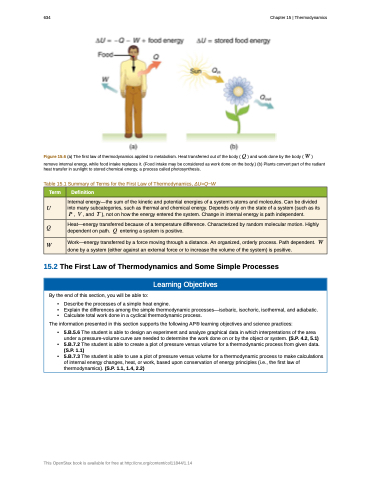Page 646 - College Physics For AP Courses
P. 646
634 Chapter 15 | Thermodynamics
Figure 15.6 (a) The first law of thermodynamics applied to metabolism. Heat transferred out of the body ( � ) and work done by the body ( � ) remove internal energy, while food intake replaces it. (Food intake may be considered as work done on the body.) (b) Plants convert part of the radiant
heat transfer in sunlight to stored chemical energy, a process called photosynthesis.
Table 15.1 Summary of Terms for the First Law of Thermodynamics, ΔU=Q−W
Term Definition
Internal energy—the sum of the kinetic and potential energies of a system's atoms and molecules. Can be divided � into many subcategories, such as thermal and chemical energy. Depends only on the state of a system (such as its
� , � , and � ), not on how the energy entered the system. Change in internal energy is path independent.
�
Heat—energy transferred because of a temperature difference. Characterized by random molecular motion. Highly dependent on path. � entering a system is positive.
�
Work—energy transferred by a force moving through a distance. An organized, orderly process. Path dependent. � done by a system (either against an external force or to increase the volume of the system) is positive.
15.2 The First Law of Thermodynamics and Some Simple Processes
Learning Objectives
By the end of this section, you will be able to:
• Describe the processes of a simple heat engine.
• Explain the differences among the simple thermodynamic processes—isobaric, isochoric, isothermal, and adiabatic.
• Calculate total work done in a cyclical thermodynamic process.
The information presented in this section supports the following AP® learning objectives and science practices:
• 5.B.5.6 The student is able to design an experiment and analyze graphical data in which interpretations of the area under a pressure-volume curve are needed to determine the work done on or by the object or system. (S.P. 4.2, 5.1)
• 5.B.7.2 The student is able to create a plot of pressure versus volume for a thermodynamic process from given data.
(S.P. 1.1)
• 5.B.7.3 The student is able to use a plot of pressure versus volume for a thermodynamic process to make calculations
of internal energy changes, heat, or work, based upon conservation of energy principles (i.e., the first law of thermodynamics). (S.P. 1.1, 1.4, 2.2)
This OpenStax book is available for free at http://cnx.org/content/col11844/1.14


